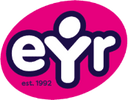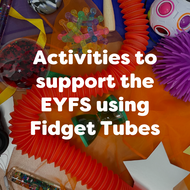Activities to Support the EYFS Using Fidget Tubes
Posted by EYR Team on 8th Dec 2021
read more
What is the EYFS?
The Early Years Foundation Stage (EYFS) is an educational stage for children aged 0-5. It sets the standard for learning and development of children in this age bracket and is used to guide early year’s practitioners. The EYFS consists of seven areas of learning which are: personal, social and emotional development, communication and language, physical development, literacy, mathematics, understanding the world and expressive arts and design.
How can learning in the EYFS be supported?
Thinking of activities to support all seven areas of the EYFS can be challenging and often requires a lot of different resources. However, with a little bit of creativity and imagination, we've suggested a few activities that will facilitate learning and development in all areas of the EYFS using just ONE resource.
Fidget pop tubes are a simple yet fantastic open-ended resource that can provide early years practitioners with the scope for endless activities. Read on to discover the many ways you can use these tubes and how they can support each area of the EYFS in turn.
Activities to support areas of the EYFS curriculum
Communication, language and literacy
The design of fidget tubes naturally lends themselves to a whole host of communication-based activities. One end of the tube can act as the receiver held up to someone’s ear, whilst the other end can function as the mouthpiece that someone else speaks through. Why not try and build upon this simple activity…

- Try and encourage the little ones to hold a few tubes together and see how this affects the sounds received through them. How many linked tubes does it take until they hear nothing?
- Play a game of Chinese whispers! Sit the children in a circle and give them a sentence or phrase to pass on through the tubes. What funny gobbledegook will you end up with at the end?
- Alternatively, try and use the tubes as a prop for storytelling. For example, the tube could act as a telescope for a pirate. Encourage children to come up with a story all about their pirate character and the mischief that they get up to.
Physical development
There is no end to the uses of these tubes when thinking of physical development activities

- Encourage the children to practice their fine motor skills by asking them to drop pom poms, bells or other small items down the tubes in a race to finish their pile.
- Test their skills by showing them a shape. For example, you could show them a star, heart or square and ask them to recreate the shapes by fastening the tubes together and bending them accordingly.
- A fun outdoor activity for the children is creating a water wall using the tubes. Try attaching them to a wire frame or wall. Children can practice their gross motor skills by pouring water into the tubes to fill a bucket at the bottom. Why not try and divide the little ones into two teams and see who can fill their bucket with water first!
Expressive arts and design
For an alternative way to use the tubes, why not encourage children to use them as an accessory in their art and craft activities?

- One way to encourage this is to use the tubes as rolling pins in dough or play. What patterns will the corrugated edges make in the dough?
- Similarly, the tubes can be rolled in paint and used as a roller to create different mark-making patterns. Encourage children to stretch and close the tubes to different lengths and see what alternative patterns they can make.
- You can use the tubes as a foundation for different models, like rockets or submarines. Encourage your little ones to add paper wings and watch them blast off into the sky!
Understanding the world
To support children’s understanding of the world, try and think about what topics to explore using the tubes…

- Why not try and use the tubes to spark different conversations about tunnels and burrowing animals? You could even create a mini burrow with the children using the tubes!
- Another conversation topic could be about the pipes themselves. Why not explore how piping works by holding one end of the tubes under the tap to provide a visual representation for the children.
Mathematics
Facilitate early maths activities...

- Sorting - Attach your tubes to a wall and place a bowl underneath. Provide your little ones with a pile of different objects. These could vary in size and colour. Then ask the children to sort the pile by colour or size, feeding objects through the tubes and into the correct bowls beneath.
- Counting - using the same set-up, why not ask them to drop a specific number of items into specific bowls and test their early maths and counting skills?
- Number recognition -bend and shape the tubes into different number shapes. Encourage your little ones to answer questions like “what number is this?” “Can you recreate it?” “Can you create the number 5?”
Personal, social and emotional development
The tactile nature of the tubes can provide a variety of open-ended sensory play opportunities:

- Children can twist, pop, stretch and wrap the tubes whichever way they want. This is great for relieving stress and releasing restless energy. Encourage some child-led play and see what creative ways your child will use the tubes!
- Why not support your little one's observational skills and take the fidget pop tubes out on a walk. See if they can spot any other cylindrical objects or encourage them to use it as a 'telescope' to spot different things, like particular coloured leaves or animals.

